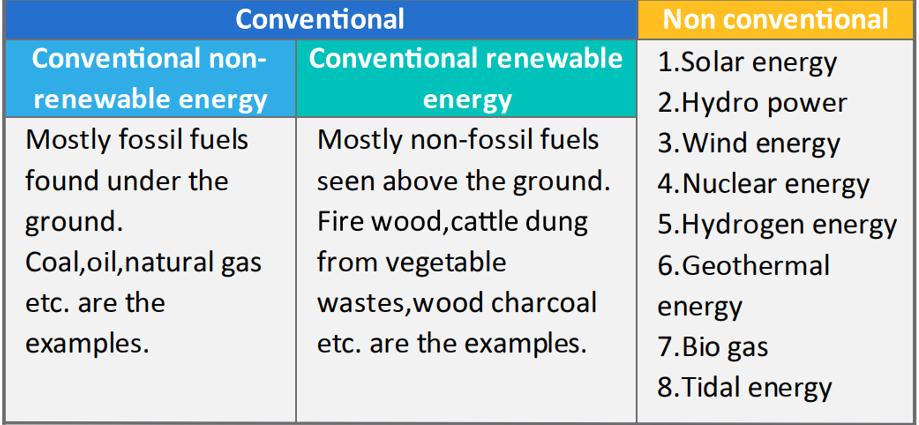Sources of energy
The following is a broad classification of sources of energy based on the consumption time.
- Traditional energy sources are easily accessible and are in use for many years.
- Non-conventional energy sources aren’t commonly employed or are not what is used in the majority of cases.

Conventional Energy Sources:
- Conventional or Non-Renewable sources of energy are finite, except hydroelectric power.
- Fossil fuels, like natural gas, coal, and oil, are among the most important non-renewable sources of power. These are the principal sources of electricity around the globe today. Around 85 percent of our energy requirements are fulfilled by the burning of fossil fuels.
- Carbon is the major component in these fossil fuels. They are a great source of energy to meet our transport requirements.
Coal
Coal is the primary resource for power. There are over 148790 coal mines in India. Between 2005 and 2006, the annual production jumped upwards to 343 million tonnes. India is the fourth largest coal-producing nation, and the deposits are located throughout Bengal, Jharkhand, Madhya Pradesh, Orissa, and Bihar.
Oil and Natural Gas
It is regarded as liquid gold and is one of the major energy sources used in India as well as around the globe. Oil and natural gas are used primarily in trains, ships, planes, and automobiles. The total production of oil within India reached 0.3 million tonnes in 1950-51 increasing to 32.4 million tons by 2000-01. It is found primarily throughout Mumbai, Gujarat, and Assam.
Read about Tips for UPSC Preparation
Advantages of Energy from fossil Fuels:
- Generating energy from fossil fuels is technologically simple and cost-effective.
- Fossil fuels have an extremely energy-efficient calorific factor.
- Fossil fuels are able to generate massive quantities of electricity in one location.
- Transporting fossil fuels like gas and oil to power stations is possible with pipelines which makes it a simple job.
- Gas-powered power plants are extremely efficient.
- The construction of power stations that operate on fossil fuels is technologically quite simple and can be constructed in nearly every location.
Disadvantages of energy from fossil Fuels:
- Pollution is the main drawback when using fossil fuels as an energy source. When the process of combustion of fossil fuels happens, lots of harmful gases (and fly-ash in the cases of coal) are released, causing pollution to the atmosphere. They include carbon dioxide, which traps the Sun’s heat and contributes to global warming. Alongside carbon dioxide and coal, it emits sulphur dioxide, which can create acid rain.
- The amount of fossil fuels available is finite and can’t be replenished. As fast as they are used up will cause their reservoirs to fill up soon.
- The extraction of fossil fuels such as coal has led to the destruction of large areas of land and has damaged the ecological balance in certain areas.
- The extraction of fossil fuels, including coal is extremely difficult and is classified as among the top risky tasks. Sometimes it puts miners’ lives at risk.
- Natural gas use may cause unpleasant odours within the vicinity.
Visit to know more about UPSC Exam Pattern
Non-Conventional Sources of Energy
Non-Conventional Sources of Energy or Renewable Energy sources are exhaustible and there is continuous production of the same. Wind energy, tidal energy, bioenergy, and solar energy are examples of non-conventional energy sources.
Wind Power
Wind energy is produced by harnessing the wind’s power and is mostly used to power irrigation water pumps. In terms of wind power generation, India is the second-largest country.
Tidal Energy
Tidal energy is produced by harnessing the sea’s tidal waves. Due to a lack of cost-effective technologies, this supply has yet to be tapped.
Bio Solar Energy
Sunlight generates solar energy. Depending on the type of power that has to be produced, photovoltaic cells are exposed to sunlight. This bio solar energy is used for cooking and water distillation.
Rationale of Renewable Energy
- Clean and Green Energy
- New Projects related to renewable sources of energy will lead to economic growth and employment opportunities.
- Growing demand for renewable sources of energy, from environmental factor
- Sustainable development goals can be achieved with non-conventional sources of Energy
To attract investors, the renewable energy market requires explicit policies and legal procedures. There is a need for clearly defined policies on renewable energy segments so that setting up renewable energy initiatives becomes simplified. Increased efforts of the government are required to attract more and more private investors. Technological hindrances need to be overcome to achieve sustainable growth of renewable energy projects.
Also read How to Prepare for UPSC without Coaching
Conclusion
Conventional energy sources still hold the majority of the markets, but given the environmental degradation, there is a need for sustainable development. To align the development goal along with environmental goals, there is a need for renewable sources of energy.
 Profile
Profile Settings
Settings Refer your friends
Refer your friends Sign out
Sign out













